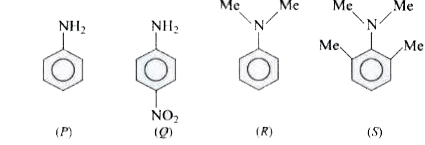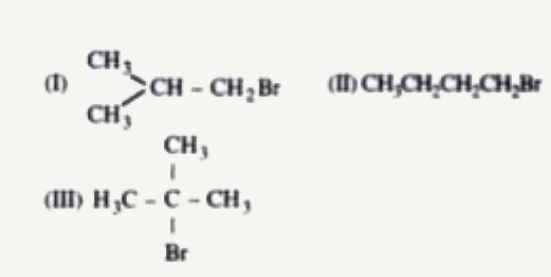Arrange the following compounds in order of increasing dipole moment .
Toluene (I) m-dichlorobenzene (II)
o-dichlorobenzene (III) . P-dichlorobenzene (IV) .
I<IV<II<III
Iv<I<II<III
I<IV<II<III
IV<II<I<III
The correct Answer is:B
To determine the order of increasing dipole moment for the given compounds (toluene, m-dichlorobenzene, o-dichlorobenzene, and p-dichlorobenzene), we need to analyze the structures and the effects of substituents on the dipole moment.
1. Identify the Structures:
- Toluene (I): This is a benzene ring with a methyl group (–CH₃) attached.
- m-Dichlorobenzene (II): This is a benzene ring with two chlorine atoms at the meta positions (1,3-positions).
- o-Dichlorobenzene (III): This is a benzene ring with two chlorine atoms at the ortho positions (1,2-positions).
- p-Dichlorobenzene (IV): This is a benzene ring with two chlorine atoms at the para positions (1,4-positions).
2. Consider Electronegativity and Bond Polarity:
- Chlorine is more electronegative than carbon, which means that the C-Cl bonds are polar, contributing to the dipole moment.
- The dipole moment is directly proportional to the bond polarity and the distance between the charges.
3. Analyze the Dipole Moment of Each Compound:
- Toluene (I): Has a small dipole moment due to the presence of the methyl group, which is weakly electron-donating.
- m-Dichlorobenzene (II): The dipole moments of the two C-Cl bonds do not cancel each other out completely, resulting in a moderate dipole moment.
- o-Dichlorobenzene (III): The dipole moments of the two C-Cl bonds add up more effectively due to their close proximity, leading to a higher dipole moment.
- p-Dichlorobenzene (IV): The dipole moments of the two C-Cl bonds cancel each other out to some extent, resulting in a lower dipole moment compared to o-dichlorobenzene.
4. Rank the Compounds:
- Based on the analysis:
- Lowest Dipole Moment: p-Dichlorobenzene (IV) - due to cancellation of dipole moments.
- Next: Toluene (I) - has a small dipole moment.
- Next: m-Dichlorobenzene (II) - moderate dipole moment.
- Highest Dipole Moment: o-Dichlorobenzene (III) - due to effective addition of dipole moments.
5. Final Order:
- The order of increasing dipole moment is:
- (IV) p-Dichlorobenzene < (I) Toluene < (II) m-Dichlorobenzene < (III) o-Dichlorobenzene.
Conclusion:
The final arrangement of the compounds in order of increasing dipole moment is:
p-Dichlorobenzene < Toluene < m-Dichlorobenzene < o-Dichlorobenzene.
- Toluene (I): This is a benzene ring with a methyl group (–CH₃) attached.
- m-Dichlorobenzene (II): This is a benzene ring with two chlorine atoms at the meta positions (1,3-positions).
- o-Dichlorobenzene (III): This is a benzene ring with two chlorine atoms at the ortho positions (1,2-positions).
- p-Dichlorobenzene (IV): This is a benzene ring with two chlorine atoms at the para positions (1,4-positions).
- Chlorine is more electronegative than carbon, which means that the C-Cl bonds are polar, contributing to the dipole moment.
- The dipole moment is directly proportional to the bond polarity and the distance between the charges.
- Toluene (I): Has a small dipole moment due to the presence of the methyl group, which is weakly electron-donating.
- m-Dichlorobenzene (II): The dipole moments of the two C-Cl bonds do not cancel each other out completely, resulting in a moderate dipole moment.
- o-Dichlorobenzene (III): The dipole moments of the two C-Cl bonds add up more effectively due to their close proximity, leading to a higher dipole moment.
- p-Dichlorobenzene (IV): The dipole moments of the two C-Cl bonds cancel each other out to some extent, resulting in a lower dipole moment compared to o-dichlorobenzene.
- Based on the analysis:
- Lowest Dipole Moment: p-Dichlorobenzene (IV) - due to cancellation of dipole moments.
- Next: Toluene (I) - has a small dipole moment.
- Next: m-Dichlorobenzene (II) - moderate dipole moment.
- Highest Dipole Moment: o-Dichlorobenzene (III) - due to effective addition of dipole moments.
- The order of increasing dipole moment is:
- (IV) p-Dichlorobenzene < (I) Toluene < (II) m-Dichlorobenzene < (III) o-Dichlorobenzene.
The final arrangement of the compounds in order of increasing dipole moment is:
p-Dichlorobenzene < Toluene < m-Dichlorobenzene < o-Dichlorobenzene.
Topper's Solved these Questions
Similar Questions
Arrange the following compounds in order of increasing dipole moment, Ethylbenzene (I), m-dichlorobenzene (II), o-dichlorobenzene (III), p-dichlorobenzene (IV)
View SolutionPolar covalent molecules exhibit dipole moment. Dipole moment is equal to the product of charge separation , q and the bond length d for the bond. Unit of dipole moment is debye. One debye is equal to 10−18 esu cm.
Dipole moments is a vector quantity. It has both magnitude and direction. Hence, dipole moment of a molecule depends upon the relative orientation of the bond dipoles, but not on the polarity of bonds alone. A symmetrical structure shows zero dipole moment. Thus, dipole moment helps to predict the geometry of a molecules. Dipole moment values can be distinguish between cis- and trans- isomers, ortho, meta and pare-forms of a substance, etc.
Q. Arrange the following compounds in increasing order of dipole moments, toluene (I), o-dichlorobenzene (II), m-dichlorobenzene (III) and p-dichlorobenzene (IV) :
View Solution
Knowledge Check
Arrange the following compounds in increasing order of acidity :
 AP>Q>R>SBS>Q>R>PCS>R>P>QDR>S>P>Q
AP>Q>R>SBS>Q>R>PCS>R>P>QDR>S>P>QArrange the following compounds in increasing order of basicity :
 AS>R>Q>PBS>R>P>QCP>Q>R>SDR>Q>P>S
AS>R>Q>PBS>R>P>QCP>Q>R>SDR>Q>P>S
Polar covalent molecules exhibit dipole moment. Dipole moment is equal to the product of charge separation , q and the bond length d for the bond. Unit of dipole moment is debye. One debye is equal to 10−18 esu cm.
Dipole moments is a vector quantity. It has both magnitude and direction. Hence, dipole moment of a molecule depends upon the relative orientation of the bond dipoles, but not on the polarity of bonds alone. A symmetrical structure shows zero dipole moment. Thus, dipole moment helps to predict the geometry of a molecules. Dipole moment values can be distinguish between cis- and trans- isomers, ortho, meta and pare-forms of a substance, etc.
Q. Arrange the following compounds in increasing order of dipole moments, toluene (I), o-dichlorobenzene (II), m-dichlorobenzene (III) and p-dichlorobenzene (IV) :
View SolutionArrange the following compound in order of increasing dipole moment :
(I) 1, 3, 5-Trichloro benzene
(II) 1, 2, 4-Trichloro benzene
(III) 1, 2, 3, 4-Tetrachloro benzene
(IV) P-dichloro benzene
View SolutionArrange the following compounds in the increasing order of their densities.

View SolutionArrange the following compounds in the increasing order in their densities.

View SolutionArrange the following compounds in increasing order of their boiling points.

View SolutionArrange the following compounds in increasing order of their boiling points
View Solution